(1959) Shirley Collins – Sweet England
“Sweet England” – a folk song collection sung by Shirley Collins
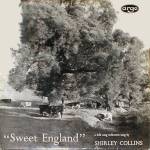 Recorded in: London, 1958, some time before July
Recorded in: London, 1958, some time before July
Recorded by: Alan Lomax, Peter Kennedy
Argo issue number: RG 150
Re-released: on LP by See For Miles in 1985 (SEE212), on CD by Topic in 1999 (TSCD815) and by Fledgling in October 2010 (FLED3080)
Availability: After the original CD release was discontinued by Topic, copies of the original Argo album exchanged hands at crazy prices: one copy went for ₤473 on eBay in February 2009, another for ₤420 in February 2010.
Musicians:
Shirley Collins – vocals, 5-string banjo
John Hasted – 5-string banjo
Ralph Rinzler – guitar
Guy Carawan – guitar
Tracks
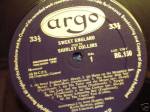 Side 1
Side 1
1. Sweet England
2. Hares On The Mountain
3. Hori-Horo
4. The Bonny Irish Boy
5. The Tailor & The Mouse
6. The Lady & The Swine
7. Turpin Hero
8. The Cuckoo
9. The Bonny Labouring Boy
10. The Cherry Tree Carol
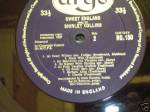 Side B
Side B
1. Sweet William
2. Omie Wise
3. Blackbirds & Thrushes
4. A Keeper Went Hunting
5. Polly Vaughan
6. Pretty Saro
7. Barbara Allen
8. Charlie
Notes:
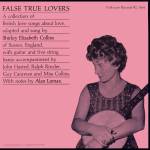 The two-day recording session at Peter Kennedy’s house in Belsize Park, London, in 1958 produced the 18 tracks on this LP and the 19-track False True Lovers released by Folkways in the USA, but only ever available in the UK as an import till Fledgling released it on CD in 2001. Still available here. I can’t work it out that Shirley Collins was 18 at the time of the recording, as some say. I make her coming up to her 23rd birthday.
The two-day recording session at Peter Kennedy’s house in Belsize Park, London, in 1958 produced the 18 tracks on this LP and the 19-track False True Lovers released by Folkways in the USA, but only ever available in the UK as an import till Fledgling released it on CD in 2001. Still available here. I can’t work it out that Shirley Collins was 18 at the time of the recording, as some say. I make her coming up to her 23rd birthday.
For a record that’s been described as capturing “a turning moment in the English folk song revival”, it’s interesting, but maybe not very surprising, that the instrumental backing on the album is provided by two Americans and a British banjo-player who learnt his trade remotely from Pete Seeger. Alan Lomax explained on the sleeve notes for False True Lovers:
“Instrumental accompaniment has not been part of the Southern English folk scene for centuries. Indeed, one might say that the American mountaineer with his banjo, rediscovered an accompanying technique for the ancient modal tradition of Britain. I think Shirley’s instinct was right in deciding to try to set her Southern English melodies to American five-string banjo accompaniment.”
A review in the Gramophone picked up on the instrumentation, saying that “purists” might object to the banjos and guitars, which added “an extra transatlantic flavour to the music”.
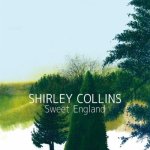 Shirley Collins says:
Shirley Collins says:
“It was towards the start of the 1950s British folk song revival and singers were looking for ways to accompany the songs – and there weren’t many good English folk guitarists or banjo players at the time, so Alan invited two Americans – Guy Carawan and Ralph Rinzler – to accompany me. But Englishman John Hasted, a physics professor at London University played banjo at the time, and so did I – although not to a very advanced level – and we both play on some tracks, too.”
Where did the songs come from?
“The songs recorded were those that were in my (very early!) repertoire at the time – some learnt at school, some at home from my grandparents and mother, although I’m pretty sure that several of those she would have learnt at school in her time, doubtless from Cecil Sharp’s Folk Songs For Schools. Others I would have found in books in the library in Cecil Sharp House.”
Did you think at the time that you were breaking new ground with the recordings?
“No, I don’t think so. I wasn’t thinking in those sorts of terms – just recording some songs that I knew. Times were changing, though, and while most record companies wouldn’t have dreamed of putting out an album of folk songs from a young singer, Harvey Usill at Argo took a bit of a leap of faith.”
How do the recordings sound to you these days?
“Young! Naïve! But some of them are rather touching, and there are some very good and lovely songs in amongst those I wish I hadn’t sung! But everyone has to start somewhere.”
Thirty-seven songs in two days means not many re-takes…
“You’re right. Possibly not even any re-takes! I don’t think anyone nowadays would consider recording 37 songs in two days – but at least I was in the hands of two expert recordists! I was right at the beginning of my career as a singer and very fortunate to have Peter and Alan as supporters.
The recordings must have been made around the same time as the first Aldermaston march. Did you go?
“No. I’m rather ashamed to say that I didn’t. My sister Dolly did, though, so I’m proud of that.”
(Thanks to Shirley for her comments)
Banjos
The story goes that when Cecil Sharp was in the Appalachians during World War I hunting folk songs, word was sent ahead of him for singers to hide away their banjos and guitars. That wasn’t what he was looking for.
And when he’d gone they’d get them out again and play their folk songs with that droning fifth banjo string regardless. And now, forty years later, here they were. In London. In Cecil Sharp House, “rediscovering an accompanying technique for the ancient 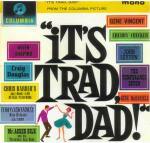 modal tradition of Britain” – an instrument that had come all the way from Arabia via the African slavery route, via the left-wing folk children of American liberals.
modal tradition of Britain” – an instrument that had come all the way from Arabia via the African slavery route, via the left-wing folk children of American liberals.
But what happened to the banjo in the sixties? My feeling is that those of us who reached our teens as the Beatles happened, lumped it alongside Russ Conway, Johnny Leyton and trad jazz as old-fashioned, as very, erm, trad, dad. Very ‘fifties.
However it happened, banjos got somewhat sidelined in the guitar-driven English folk-rock scene. By 1971, not one of the wonderful cast turned up for the recording sessions of No Roses with a banjo.
But in those days you couldn’t move for  them. American folk groups had them, trad jazz bands had them, skiffle groups had them (Shirley Colllins sang with both John Hasted’s Skiffle and Folksong Group and Alan Lomax’s Ramblers – pictured right) and The Black and White Minstrel Show – the BBC’s hit family entertainment show that was launched at the same time this LP was recorded – had loads of them.
them. American folk groups had them, trad jazz bands had them, skiffle groups had them (Shirley Colllins sang with both John Hasted’s Skiffle and Folksong Group and Alan Lomax’s Ramblers – pictured right) and The Black and White Minstrel Show – the BBC’s hit family entertainment show that was launched at the same time this LP was recorded – had loads of them.
Funny to think that that ‘traditional’ style of British folk guitar that we know and love was still being invented at the time by the likes of Steve Benbow and Davey Graham.
Apropos of which, Shirley Collins re-recorded three of the tracks on this LP with Davey Graham on their New Routes Folk Routes six years later. By that time Graham had invented the British folk guitar and Shirley Collins is singing more from the hips.
The Sweet England team
Shirley Collins had known John Hasted and Peter Kennedy from her early days (late 1953 onwards) at Cecil Sharp House. “They encouraged us by giving us an informal space where we could sing”, she says in her autobiographical account of her time with Lomax, America Over the Water.
Hasted, a forgotten hero of the 50s folk revival, was an Oxford-educated, communist atomic physicist and a militant in the Workers’ Music Association, birthplace of “that little red label”, Topic. (For an appreciation of his life, see the 2002 section of the Works in Progress pages of Karl Dallas’ web site). He’d been inspired to take up the banjo, which he later taught to Shirley Collins, by hearing Pete Seeger.
So too had American Ralph Rinzler, who was primarily a banjo and mandolin player, though he accompanies Collins on guitar here. He had cut short a study trip to Paris and headed for London in 1957 at the suggestion of Pete’s (Seeger’s, Keep up!) half-sister, banjo-playing Peggy Seeger. Enough banjo players already?
In London Rinzler collected songs in Camden Town pubs, met Lomax, and made a living accompanying Dominic Behan, A.L. Lloyd and Ewan Maccoll at recording sessions and gigs. “There weren’t any instrumentalists back in the ’50s. That came in the ’60s,” he recalled later. Back in the States in 1959, he would join the wonderful Greenbriar Boys and go on to found the Smithsonian Institution’s Office of Folklife Programs.
(in the pic below is Rinzler with fellow Greenbriar Boy John Herald on the right and a bloke in a cap)
Guy Carawan, meanwhile, had been staying at Alan Lomax’s London pad en route to the World Youth Festival in Moscow in 1957 (attended by Maccoll, Peggy Seeger, Hasted, Benbow and Shirley Collins). Carawan went on from Moscow to China with Peggy Seeger, had his U.S. passport taken away from him as a result, so was back in London when the Sweet England recordings were made.
There’s a nice contemporary pictorial feature on the Festival in Life magazine, including a pic of Carawan and Seeger singing ‘Going to lay down that atomic bomb’. Click here.
 (Right – the US delegation enters the Lenin Stadium, Moscow, 1957. Photo by kind permission of Robert Carl Cohen, whose online photo and film record of moments in “radical history” is well worth a visit)
(Right – the US delegation enters the Lenin Stadium, Moscow, 1957. Photo by kind permission of Robert Carl Cohen, whose online photo and film record of moments in “radical history” is well worth a visit)
Back in the States in 1959, Carawan began a lengthy association with the Highlander adult education centre In Tennessee, marrying his performing career with civil rights activism and community music projects.



While I appreciate your finding that my photo of Americans entering Lenin Stadium in Moscow during the Sixth World Youth Festival in 1957 merits posting on your website, would you please credit the source: .
Hi, a small error: The Topic CD reissue of Sweet England was TSCD818. 12TS238 was the order number of the Topic LP Adieu to Old England.
I just noticed by chance that Sweet England will be reissued by Fledg’ling Records as FLED 3080 tomorrow (October 25)
thanks reinhard. that’s good news.
Dear folkcatalogue
I’ve recently acquired a copy of sweet england SEE212 Mono See for miles records Ltd dated 1987 not 1985 as stated above. Was there a second batch?
Great website. Thanx
Hmmm! I’ve no idea. But almost certainly.
I have a copy of the original LP recording of Sweet England and would be interested to know how much it is worth today?